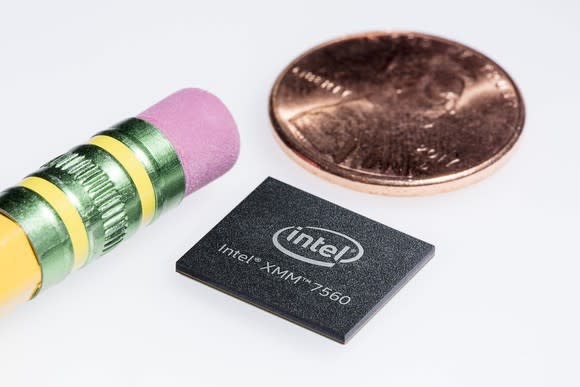How Much Revenue Does Intel Generate From the Apple iPhone?
Chip giant Intel (NASDAQ: INTC) has been in the cellular modem business since it closed its acquisition of Infineon Wireless -- a then-struggling maker of cellular modems -- early in 2011. This acquisition became a money pit for Intel as Infineon Wireless' product portfolio wasn't competitive. Intel had to dramatically boost its investments in modem products to have salable products.
Intel's modem business finally got its big break in the second half of 2016, when Apple (NASDAQ: AAPL) adopted the company's XMM 7360 LTE modem in some of its iPhone 7 series smartphones. The momentum continued, as Apple used Intel modems in the company's latest iPhone models and Apple continued selling the older iPhone 7 series devices.
Intel doesn't break out exactly how much revenue it generates from modem sales to Apple, but I can provide an estimate.
A big number
Intel's modem sales fall under the company's client computing group (CCG) reporting segment. CCG revenue is reported in two subsegments: platform revenue and adjacent product revenue. Intel's modem sales fall in the latter category.
According to Intel's most recent annual filing, which covers the year ending Dec. 30, 2017, the company saw a roughly $600 million year-over-year increase in CCG adjacent product revenue in 2016. In 2017, Intel notched an additional $600 million boost in adjacent product revenue. Those are year-over-year increases of 40% and 29%, respectively and the subsegment reported roughly $2.8 billion in net revenue in 2017.

Image source: Intel.
Intel claims in its annual filing that the increases in adjacent product revenue in both years were "primarily modem." That doesn't mean entirely modem, but I think modem shipment growth represents the substantial majority of the growth.
For some context, in 2015, the revenue from Intel's adjacent products actually declined 6% year over year. Additionally, CCG's adjacent product revenue was approximately flat year over year during the first two quarters of 2016 (the last two quarters that didn't include any modem sales to Apple).
It wouldn't be a stretch to assume, then, that practically all of the revenue growth that Intel has seen in CCG's adjacent products business came from increased modem sales to Apple. In that case, Intel's modem business appears to be generating over $1 billion per year in revenue.
More growth ahead
Intel had a minority share of iPhone modem shipments during the iPhone 7 cycle, and it likely has a minority share in the iPhone 8 series and iPhone X smartphones.
According to a recent report from respected analyst Ming-Chi Kuo with KGI Securities (via MacRumors), Apple will use Intel modems exclusively in the upcoming trio of iPhones. Additionally, Apple's iPhone 7 series devices (which incorporate Intel modems) are likely to replace the iPhone 6s series (which do not) at the low end of the product stack, further boosting Intel's modem share during the next iPhone product cycle.
If Kuo's information is good -- and I think it is -- then Intel's modem business looks set for another year of significant growth in 2018 as Intel stands to more than double its unit share in Apple's newest iPhone models (and at potentially higher average selling prices, since Intel's latest modems look much more competitive than the previous models were).
More From The Motley Fool
Ashraf Eassa owns shares of Intel. The Motley Fool owns shares of and recommends Apple. The Motley Fool has the following options: long January 2020 $150 calls on Apple and short January 2020 $155 calls on Apple. The Motley Fool recommends Intel. The Motley Fool has a disclosure policy.

 Yahoo Finance
Yahoo Finance 